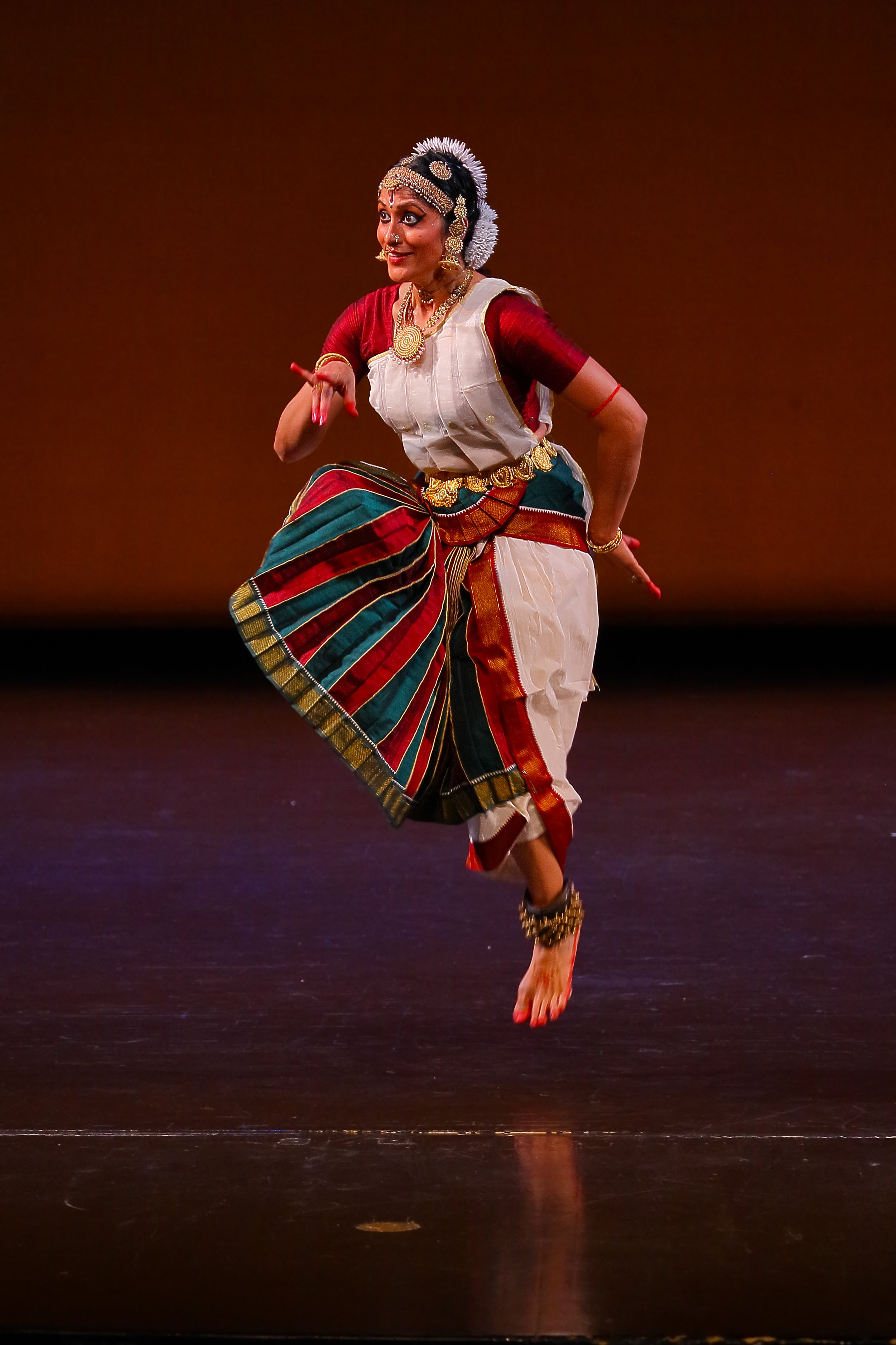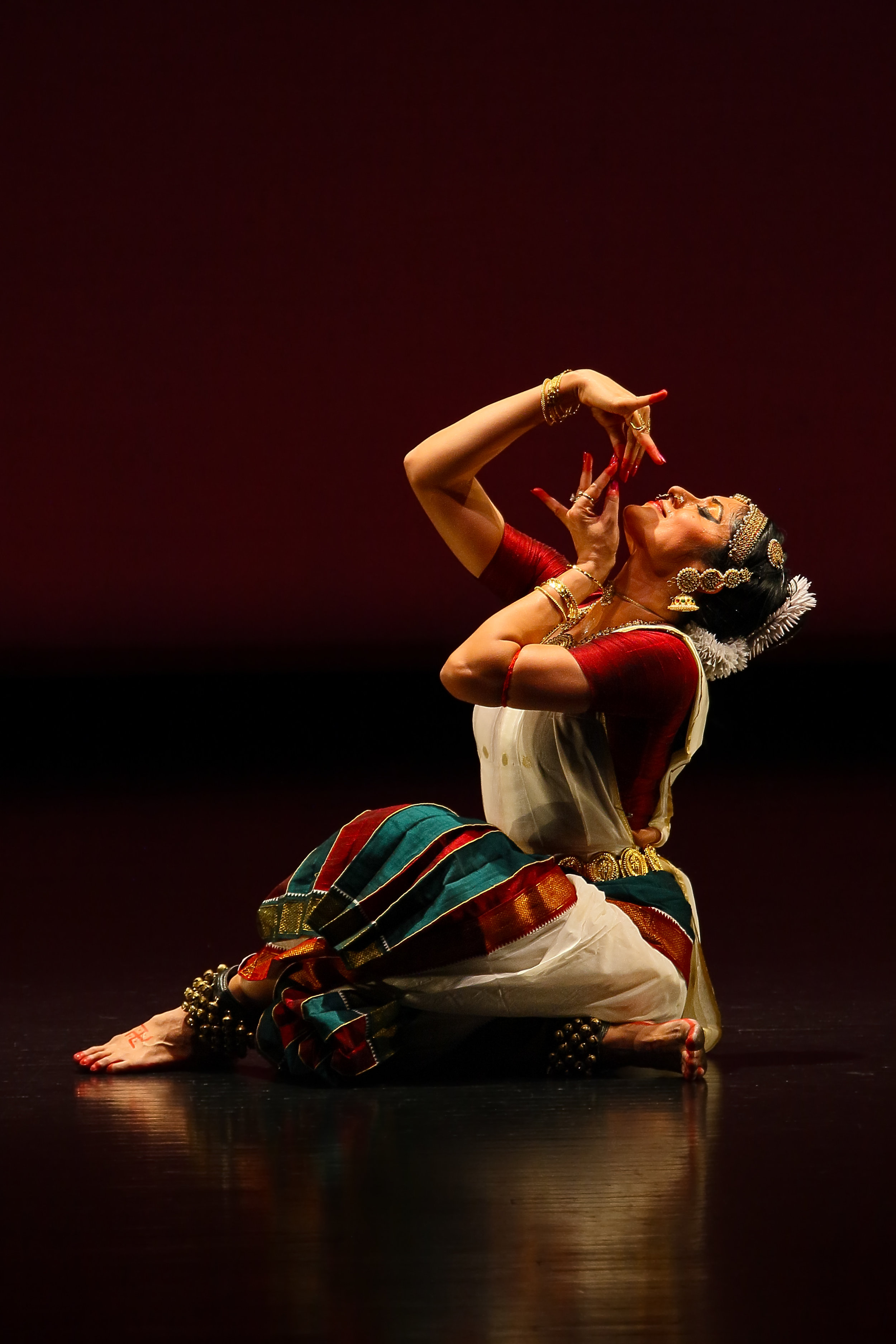Photos of Dr. Janaki Rangarajan in Samah: Dance of Mystic Poetry, by Srinivasan Govindarajan.
Srilatha Singh, of ChitraKaavya Dance, has a passion for presenting high quality Bharatanatyam to Salt Lake City audiences. I have had the pleasure of being an audience member for some of these performances: previously, for Renjith and Vijna performance, Samarpanam, in the fall of 2017, and, now recently, for Dr. Janaki Rangarajan performance of Samah: Dance of Mystic Poetry at the Jeanne Wagner Theatre.
I was also involved when Ragamala Dance Company performed at Kingsbury Hall in 2016; Singh, Raksha Karpoor, Liz Stich, and I performed a piece that was a collaboration of modern dance and Bharatanatyam to open the show. I preface with all of this to say that I have had exposure within this cultural art form, but am in no way well-versed in its nuance. I left Samah with a desire to understand more from the perspective of someone that was more well-versed. Thankfully, Singh and I were able to meet and the following are highlights from our conversation.
Bharatanatyam is an ancient South Indian dance form that was traditionally done as a solo by women in Hindu temples for elite, extremely select, and primarily male audiences. There was much conflict over its existence during British colonial rule; many classical Indian dance forms were ridiculed and discouraged. An “anti-dance movement” arose from this conflict, which accused dance of being a form of prostitution, and culminated in the British government banning Hindu temple dancing altogether in 1910.
When Rukmini Devi Arundale helped to revive Bharatanatyam in the 20th century, it was both taken out of the temples and relieved of any sensuality and sexuality, arguably in an attempt to gain traction and shed its former, alleged connection with prostitution. One of the many things that Singh finds so profound in Rangarajan’s dancing is that, while most contemporary Bharatanatyam dancers continue the mainstream tradition of keeping their hips and pelvis centered, Rangarajan has also been trained in the movement vocabulary called Karana, as reconstructed by her guru, Dr. Padma Subramaniam, as her life’s work. Karana allows the hip to be off-center in sculpturesque angles. With this subtle change, dancers re-integrate the sensual origins of the form, and Singh views Rangarajan’s personal interpretation as skillfully towing the line of adding sensuality without crossing over into the vulgar.
I was not fully aware of this history, or of this deliberate attempt by Rangarajan, but I did gather the effects just by watching her perform. I interpreted her moving body as a full-bodied and multi-dimensional woman, aware of her sensuality and sexual power, but also interested the portrayal of other aspects of the human (or divine) experience. One portrayal did not take precedence over the other. She was simultaneously euphoric, devoted, devastated, sublime, and ordinary. These states of being were housed and manifested in her flesh-and-bone body - a body that she was able to transcend while fiercely staking claim to it.
Singh and I also discussed Bharatanatyam moving forward, and how Singh thinks the form could possibly evolve to gain wider audiences (and also, what will remain constant in the form without compromise). As I watched Rangarajan’s performance, I was surprised at the sheer length of it. As a solo performer, she was onstage for just under two hours, interpreted five different poems, and spoke in between each one, with minimal rest backstage throughout. I can’t imagine the stamina, both physical and mental, that was necessary.
Consequently, the viewing experience also asks a certain stamina of the audience. I found beauty in settling into a lengthy solo performance, a respite from the often scattered and short attention spans littered with sound bytes and social media quips. But, I wondered how this functioned with mass audiences, especially those that are predominantly non-Indian.
While I gleaned much from Rangarajan’s storytelling, Bharatanatyam is essentially a form of sign language, the dancers telling plot-based stories familiar to those raised in the tradition. Immediately accessible to me were her virtuosic dancing, the rhythms, the specificity of her arms moving with her legs, and the layer of choreography that was her face and eyes, but I did not know the literal meanings of many gestures, nor did I have access to the music (sung or spoken in a variety of languages, including Tamil, Kannada, Persian, Kashmiri, Punjabi, Hindi, Maithili, and Sanskrit) in the way that Singh does.
Will this art form experience a "Balanchine moment," in which the plot is forsaken for a non-literal musical interpretation? Could it even go a step forward, à la Merce Cunningham, and divorce itself from the music to see what remains of an abstracted body moving through space? Singh cannot imagine this happening, as emotion and storytelling are at the core of why the dancers move to begin with. This idea was highlighted in our collaboration in 2017: Stich and I would explain our movement choices in terms of spatial arrangement and internal impulse motivation (i.e., doing what “feels” right), while Karpoor and Singh would respond with what the music was saying and how their movements directly corresponded.
Should somethings remain unchallenged? Should we always be jabbing at tradition with innovation? Would anything worthwhile be left if we pushed and pulled at the rich tradition of Bharatanatyam? These were my own questions, though I’m not sure Singh felt my angst within my probes - which makes sense. I am looking through the lens of modern dance, a movement tradition that was born in the 1900s through the rejection of traditions that came before it, and then continued, and still continues, to turn itself inside and out each decade. We dance to the music, then alongside it, then against it, and sometimes without it… and while I find this interesting, I cannot say modern dance’s exploratory nature has gained it mass appeal as a form.
Instead of these questions, Singh wonders if it would be advantageous to educate audience members more about Bharatanatyam prior to a performance. Each show she has presented has maintained a nice balance of speaking before the performance to welcome but also to enlighten the audience about what they will see. Does there need to be more explanation in order for wider audiences to walk away feeling fulfilled? In the case of Rangarajan’s performance, my response was, “No.” Though I could not historically or academically detail all that occurred, I was transported nonetheless. Rangarajan wove the history of her own body with questions and affirmations of love, despair, and joy with a commitment that I have hardly experienced before. I was left wanting to engage more with what I experienced at Samah: Dance of Mystic Poetry- an indication that art did what it should.
Erica Womack is a Salt Lake based choreographer. She teaches at SLCC and regularly contributes to loveDANCEmore.



